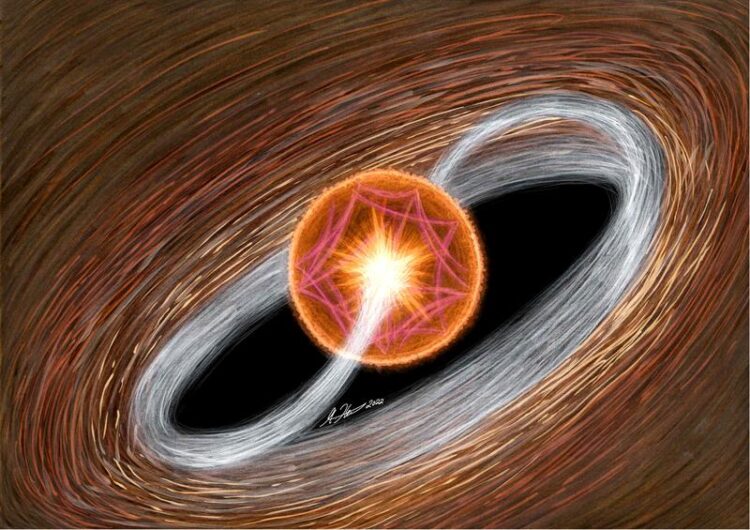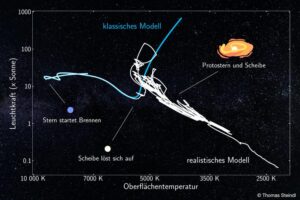Astrophysics: Star-childhood shapes stellar evolution

The young star in the centre is in a molecular cloud and is enveloped by a disk. In the first stages of its life, the star attracts materials, for example, through magnetic fields, which are constantly remixed in the turbulence.
Credit: Mirjana Keser
In classical models of stellar evolution, so far little importance has been attached to the early evolution of stars. Thomas Steindl from the Institute of Astro- and Particle Physics at the University of Innsbruck now shows for the first time that the biography of stars is indeed shaped by their early stage. The study was published in Nature Communications.
In classical models of stellar evolution, so far little importance has been attached to the early evolution of stars. Thomas Steindl from the Institute of Astro- and Particle Physics at the University of Innsbruck now shows for the first time that the biography of stars is indeed shaped by their early stage. The study was published in Nature Communications.

(c) Thomas Steindl
From babies to teenagers: stars in their “young years” are a major challenge for science. The process of star formation is particularly complex and difficult to map in theoretical models. One of the few ways to learn more about the formation, structure or age of stars is to observe their oscillations. “Comparable to the exploration of the Earth’s interior with the help of seismology, we can also make statements about their internal structure and thus also about the age of stars based on their oscillations” says Konstanze Zwintz. The astronomer is regarded as a pioneer in the young field of asteroseismology and heads the research group “Stellar Evolution and Asteroseismology” at the Institute for Astro- and Particle Physics at the University of Innsbruck. The study of stellar oscillations has evolved significantly in recent years because the possibilities for precise observation through telescopes in space such as TESS, Kepler, and James Webb have improved on many levels. These advances are now also shedding new light on decades-old theories of stellar evolution.
With a new model to zero hour of adult stars
Stars are called “children” as long as they are not yet burning hydrogen to helium in their cores. At this stage, they are on the pre-main sequence; after ignition, they become adults and move onto the main sequence. “Research on stars has so far focused mainly on adult stars – such as our Sun” says Thomas Steindl, a member of Konstanze Zwintz’s research group and lead author of the study. “Even if it sounds counterintuitive at first glance, so far little attention has been paid to the evolution of the pre-main sequence because the phase is very turbulent and difficult to model. It’s only the technological advances of recent years that allow us a closer look at the infancy of stars – and thus at that moment when the star begins to fuse hydrogen into helium.” In their current study, the two Innsbruck researchers now present a model that can be used to realistically depict the earliest phases of a star’s life long before they become adults. The model is based on the open-source stellar evolution program MESA (Modules for Experiments in Stellar Astrophysics). Inspired by a talk given by astronomer Eduard Vorobyov of the University of Vienna at a 2019 meeting, Thomas Steindl spent months refining the method for using this stellar evolution code to recreate the chaotic phase of early star formation and then predict their specific oscillations. “Our data show that stars on the pre-main sequence take a very chaotic course in their evolution. Despite its complexity, we can now use it in our new theoretical model.” Steindl said. Thus, the astronomer shows that the way the star is formed has an impact on the oscillation behaviour even after ignition of nuclear fusion on the main sequence: “The infancy has an influence on the later pulsations of the star: This sounds very simple, but it was strongly in doubt. The classical theory assumes that the time before ignition is simply irrelevant. This is not true: Comparable to a musical instrument, even subtle differences in the composition lead to significant changes in the tone. Thus, our modern models better describe the oscillations in real stars.”
Konstanze Zwintz is delighted with this discovery and is very optimistic about the future: “I was already convinced about 20 years ago, when I first saw the oscillation of a young star in front of me on the screen, that I would one day be able to prove the significance of early stellar evolution on the ‘adult’ star. Thanks to the great work of Thomas Steindl, we have now succeeded: Definitely a eureka moment for our research group and another milestone for a better understanding of the growth steps of stars.”
Publication:
The imprint of star formation on stellar pulsations. Thomas Steindl, Konstanze Zwintz, Eduard Vorobyov. Nature Communications 2022
DOI: 10.1038/s41467-022-32882-0
https://www.nature.com/articles/s41467-022-32882-0
Wissenschaftliche Ansprechpartner:
Thomas Steindl, MSc
Institut für Astro- and Teilchenphysik
Universität Innsbruck
Tel.: +43 512 507 52031
Mobil: +43 681 81572927
E-Mail: Thomas.Steindl@uibk.ac.at
Univ.-Prof. Konstanze Zwintz
Institut für Astro- and Teilchenphysik
Universität Innsbruck
Mobil: +43 664 5327811
E-Mail: konstanze.zwintz@uibk.ac.at
Originalpublikation:
The imprint of star formation on stellar pulsations. Thomas Steindl, Konstanze Zwintz, Eduard Vorobyov. Nature Communications 2022
DOI: 10.1038/s41467-022-32882-0
https://www.nature.com/articles/s41467-022-32882-0
Media Contact
All latest news from the category: Physics and Astronomy
This area deals with the fundamental laws and building blocks of nature and how they interact, the properties and the behavior of matter, and research into space and time and their structures.
innovations-report provides in-depth reports and articles on subjects such as astrophysics, laser technologies, nuclear, quantum, particle and solid-state physics, nanotechnologies, planetary research and findings (Mars, Venus) and developments related to the Hubble Telescope.
Newest articles

Properties of new materials for microchips
… can now be measured well. Reseachers of Delft University of Technology demonstrated measuring performance properties of ultrathin silicon membranes. Making ever smaller and more powerful chips requires new ultrathin…

Floating solar’s potential
… to support sustainable development by addressing climate, water, and energy goals holistically. A new study published this week in Nature Energy raises the potential for floating solar photovoltaics (FPV)…

Skyrmions move at record speeds
… a step towards the computing of the future. An international research team led by scientists from the CNRS1 has discovered that the magnetic nanobubbles2 known as skyrmions can be…





















